Family : Rallidae

Text © Dr. Gianfranco Colombo

English translation by Mario Beltramini

Relative of cranes, the moorhen (Gallinula chloropus) is one of the most diffused birds in the world, present in the temperate and tropical zones of all continents © G. Mazza

Immediately noted for the yellow vermilion beak like the frontal shield and the white undertail that when swimming often raises defiantly to send messages to similars © Gianfranco Colombo
Besides their ancestral habitats, it has been able to conquer sites by sure not suitable for its way of life while being an aquatic bird provided with a discreet verasatility, adapting to sites and to a feeding often well different from its normal habits.
Though endowed with short and stubby wings and of a fairly heavy flight, its has been able to conquer continents and sometimes to reach lands so much isolated and unsuitable to lead to think that its presence was a contrived work done by the man.
Yet its arrival on the Svalbard Islands, at Jan Mayen and in Greenland has been confirmed, locations surely not easy to reach even for a bird linked to the aquatic habitat and by sure absolutely unfriendly for the same.
On these present day it’s a usual fact to see these birds frolicking curious together with pigeons and mallard ducks under the benches of the park where we are quietly sitting or swimming with their typical jerky gait, with a continuous back and forward movement, with the tail straight like a banner, a very few metres away in the adjacent small lake, followed by their brood, small black and chirping tufts.
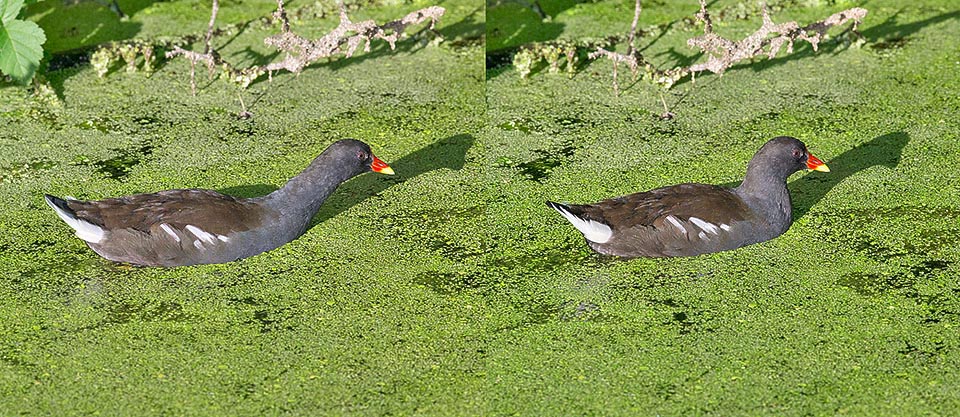
It is easily identified also for the way of swimming, jerkily, well different from the ducks' one, with a continuous movement back and forward of the head © Giuseppe Mazza
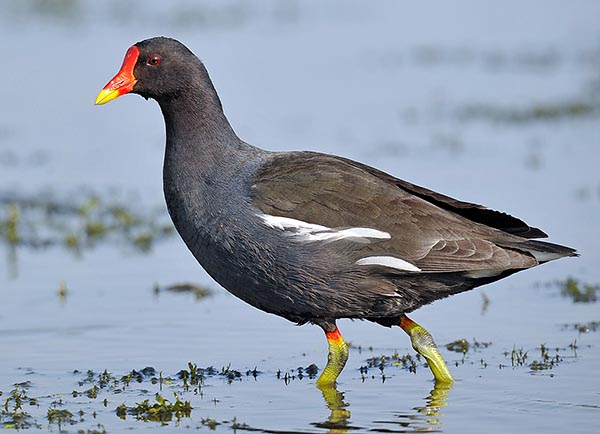
The back and the alar cover is opaque olive black whilst the belly is compact slate black with metallic reflections. Red iris, greenish legs and a bizarre red garter at the base of the tibia © Gianfranco Colombo
Conversely, it is probable that the exact origin of this vulgar name comes from merehen, hen of the lakes, rightly misspelled then in moorhen.
In German it is called Teichhuhn, in Spanish Gallineta Común, in French Gallinule poule-d’eau, in Portuguese Galinha-d’água, in Italian Gallinella d’acqua and finally, in English, rightly, Moorhen.
The etymology of the scientific name gets its origin from the Latin for the genus Gallinula, small hen and from the Greek for the species chloropus, from “khloros”, green and “pous”, foot. Hence, gallinule with green feet.
And here is an original anedocte about this bird. Though being not webbed, it is able to swim admirably by launching backwards nervous and quick shots with the feet and even being able to stay totally underwater, when menaced by external threats, leaving out in the surface only the bill for breathing, like a periscope. A technique called “water treading”.

Gallinula chloropus shows a quarrelsome nature all the year round, often due to the alleged danger of a possible invasion of its territory or to the mutual idea that the competitor attacks. So rise furious and violent fights with shots of legs and violent scratches followed by chases on the water and several attemts to drown the adversary keeping it under water © Gianfranco Colombo
It appears that, in order to realize this operation, the gallinule removes all air from the air sacs and forcing the exit of the air caught in the feathers.
In this position, it goes totally unobserved for long time till when the danger has gone.
Zoogeography
Seen the vastity of its range, it would be easier to state which are the areas not occupied rather than those colonized. The moorhen, in its various subspecies, at times upgraded to new species, lives extensively practically in all the continents in their temperate and tropical parts and with increasingly expanding territories. Are excluded the areas in the extreme north or south, depending on the hemispheres.
It has colonized remote oceanic islands such as St. Helena and the Seychelles, the Açores and Mauritius, the Mariana and the Kermadec Islands, the Hawaii and the Galapagos. A diffusion so ample to be considered as rather strange for a bird of that type. It is absent in the desert, mountainous zones, in the thick forests, in the steppes and in the dry prairies. The Gallinula chloropus is absent also in part of Oceania where it is replaced by the species Gallinula tenebrosa, a practically similar bird, if it had not a different colour of the feet.
Ecology-Habitat
Bird indissolubly linked to water, the moorhen lives in any habitat where this element is present.
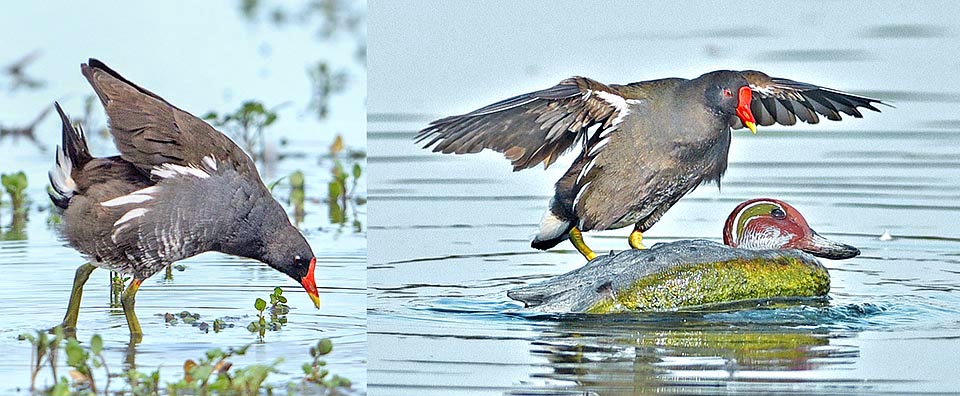
Males and females start resolute to attack, head down, against any intruder ... even the floating false small duck of a hunter © Gianfranco Colombo
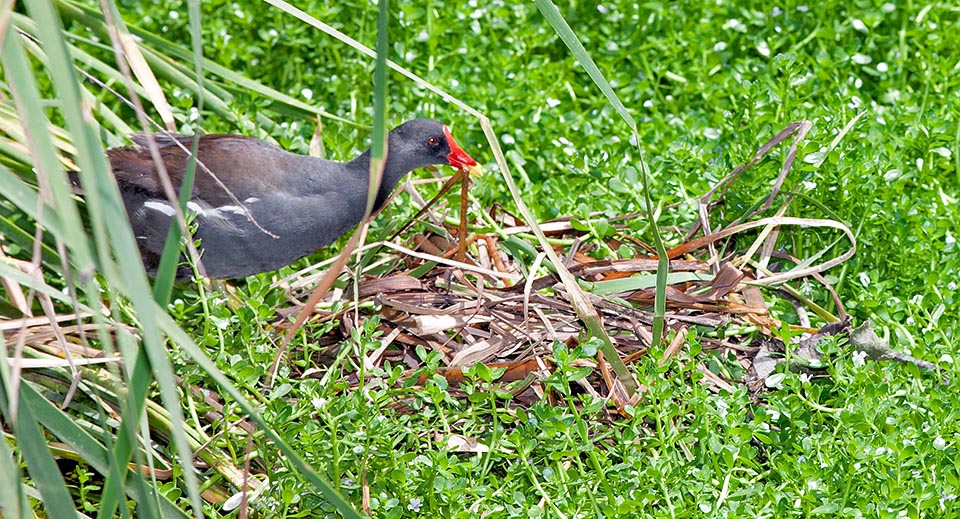
The nest, often floating among the reeds, is built by both parents who share also the brood, lasting three weeks as an average © Giuseppe Mazza
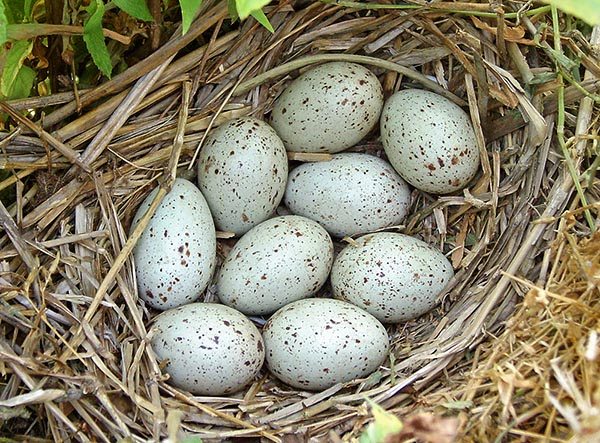
The cream coloured eggs, highly spotted of reddish brown, are at least 5 and sometimes even a dozen © Museo Civico Lentate sul Seveso
Neverthelerss, once the danger is gone, here they are again on the dry land, walking with absolute ease among the persons as if they were protected by them.
Morpho-physiology
At some distance, the livery of the moorhen is totally black in all its parts and both sexes exhibit the same plumage.
Only when at close quarters, we can note some shades and the only coloured particulars that in some seasons and depending on the age, modify slightly this livery.
The back and the wing cover is opaque olive black and without any metallic reflection whilst the abdomen is black slate, compact and translucent.
The beak, that has a slight shield going up on the front, is of a very lively vermilion red colour with the tip orange yellow.
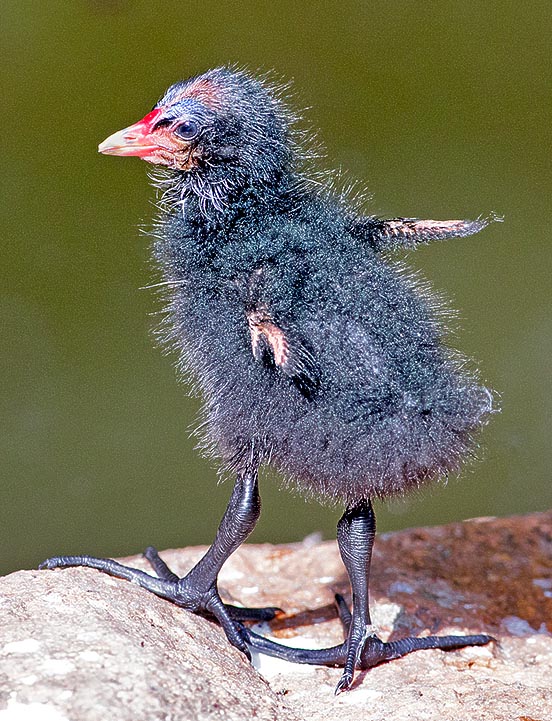
The newborns, covered by a thick black down, are decidedly nidifugous and curious. Moving their wings stumps, but already gritty on solid legs, they leave the nest very few days after birth © Giuseppe Mazza
The undertail, always shown in any movement, is candid white and serves as means of communication with its similars. Finally, on the sides at the height of the underwing, stands a white line broken in half and more or less evidenced depending on the individuals.
The young are very similar to the adults when in winter livery and do not show the red of the beak and the typical black colour of the livery that, conversely, is completely olive brown.
The maturity is however reached already by the end of the first year of life.
The dimensions of this bird are almost the same in any congener of subspecies.
The weight is of about 300 g, the length is of 30 cm and the wingspan reaches the 60 cm.
Various subspecies have been classified despite their characteristics rather similar for each other.
The Gallinula chloropus chloropus, the typical form living in Europe, North Africa and with a more or less continuous stripe up to Japan and South-East Asia.
The Gallinula chloropus meridionalis, that occupies the sub-Saharan part of Africa.
The Gallinula chloropus pyrrhorrhoa, the endemic subspecies of Madagascar, Comoro Islands, Réunion and Mauritius and
The Gallinula chloropus orientalis, living in the northernmost part of Indian Ocean, the Seychelles, the Andaman Islands, the Indo Malayan Peninsula up to Indonesia and Philippines.

Though able to feed independently, the pullets ask continuously for food, assisted by parents who follow them for various weeks © Giuseppe Mazza
We have talked of very elongated and endowed of strong claws fingers, characteristics absolutely necessary for this bird. The long fingers, like all nails, have the purpose of facilitating the walking in shallow waters, leaning on the surface weeds without sinking.

Reassuring beakful. The often unwary chicks death rate is very high but when one year old Gallinula chloropus is already able to reproduce with a lifespan of about 12 years © Giuseppe Mazza
There is not a moment that competing males, even if placed at tens of metres far away, stare askance with aggressive postures and after a head down approach, start furious and violent battles with clashes with blows of paws and violent scratches followed by chases on the water and attempts to drown the competitor holding it under water.
Undoubtedly we might compare them to the fights of the bantam cocks, but done in the water, seen then the damages often they cause each other.
As a matter of fact, it is not rare to see birds with broken fingers if not even with broken legs. Yet, it’s their innate character.
A quarrelsome nature all over the year, often justified by the alleged danger of a possible invasion of its own territory or by the mutual idea that the adversary is attacking it even if placed hundred metres far away and little visible.

Growing pullets with mother. They eat all what met on their path: molluscs, small fishes, larvae of insects and tadpoles, algae, grasses, seeds and fruits © Giuseppe Mazza

In the young prevail the brown shades. The undertail, here raised defiantly, is already white © G. Mazza
In this case the females are more combative and do not disdain equal combats with the rivals in order to maintain the position acquired with the male.
Despite being a monogamous subject, the male occasionally may become polygamous with a family widened to more females.
In this not frequent case, we can be present to the common deposition with broods formed by an abnormal number of eggs.
The moorhen is a very prolific species that lays twice and occasionally even thrice a year, and this undoubtedly contributes to its great success in conquering new areas.
The nest is a heap of dried weeds, of phragmites, grasses and dried leaves, often built in the reedbeds and floating.
Usually, it chooses the grassy banks of the water bodies, the edges of an islet, of a mass of mud or suspended over a bramble close to a water stream or even directly on trees covered by green climber at a height of various metres.

Though linked to water, Gallinula chloropus has been able to conquer sites surely unsuitable for its way of life with presences in the city parks and in totally unexpected places such as Greenland © Giuseppe Mazza
The number of eggs varies considerably with a range going from 5 to 12. The eggs are fairly big, of cream colour and strngly spotted of reddish brown.
The chicks are nidifugous and leave the nest after a very few days from the birth, helped by the parents that will follow them for various weeks more although already capable to feed independently. They come to life covered by a thick black down they keep until the first juvenile moulting.
The moorhens eat all what they find along their way. Small mollusks and fishes, larvae of insects and tadpoles, algae, plants and seeds but do not disdain maize kernels, seeds and fruits. A times they predate the nests of the small birds that nidify on the ground, eating unscrupulously the nestlings as well as the eggs.
The same greed it shows in hunting is unluckily paid back by the nature with a very strong predation of its broods. Mice, mustelids and Grey herons (Ardea cinerea) are the main predators of this bird.
Particularly the latter, with its proverbial patience is able to wait for the exit of the chicks hidden into the riparian greenery and catch, one by one, the whole brood.
But the danger may come also from down below. In deep enough waters the pikes (Esox lucius) often easily catch these small floating beings. The very great prolificacy and the very vast area occupied by this bird does not raise in any way problems of survival to this species. The moorhen may exceed the 12 years of life.

Mother with already grown chick: beak and legs are already colouring. Despite the numerous predators it's an expanding species without any danger © Giuseppe Mazza
Fulica chloropus Linnaeus, 1758.
→ To appreciate the biodiversity within GRUIFORMES please click here.
